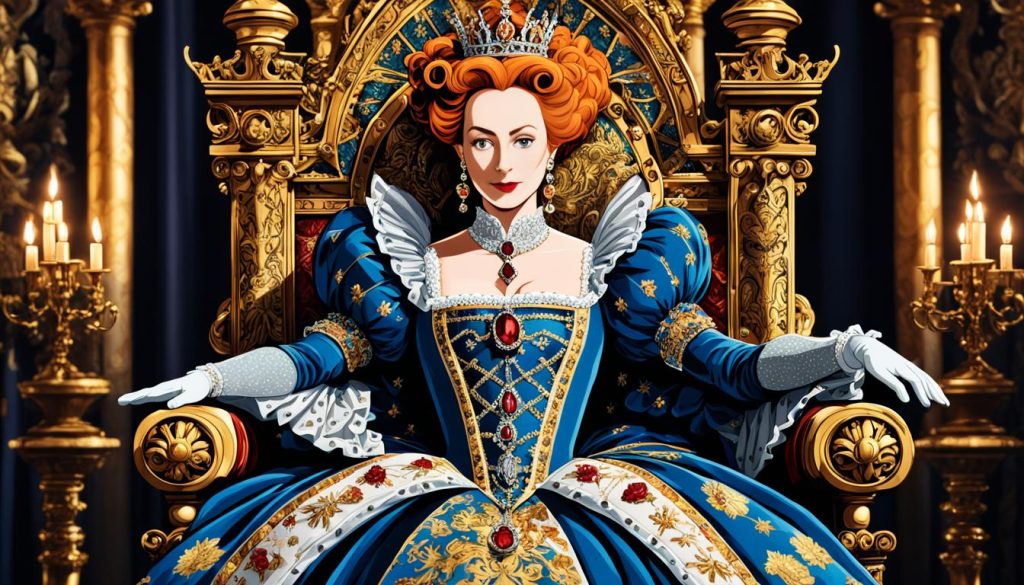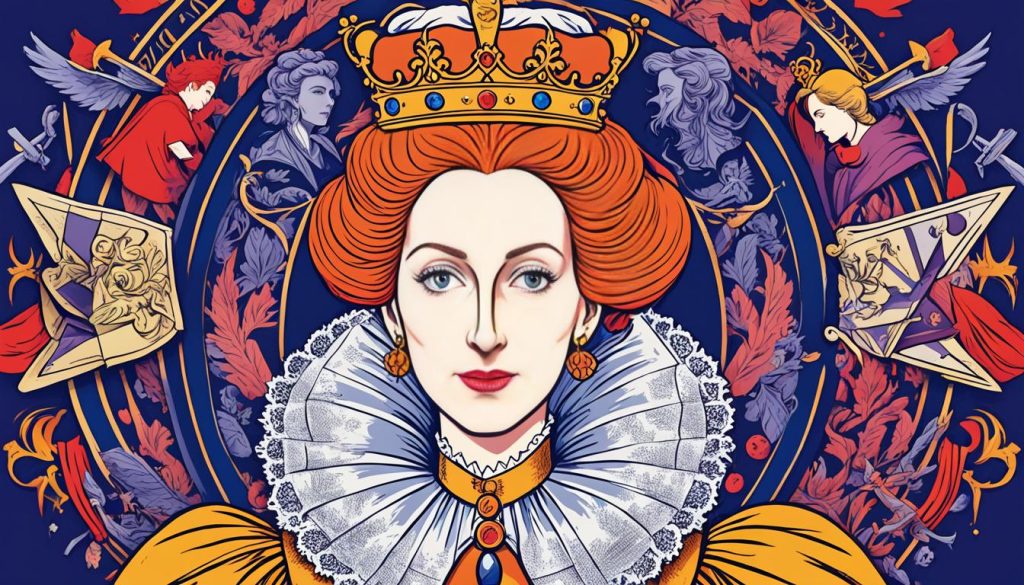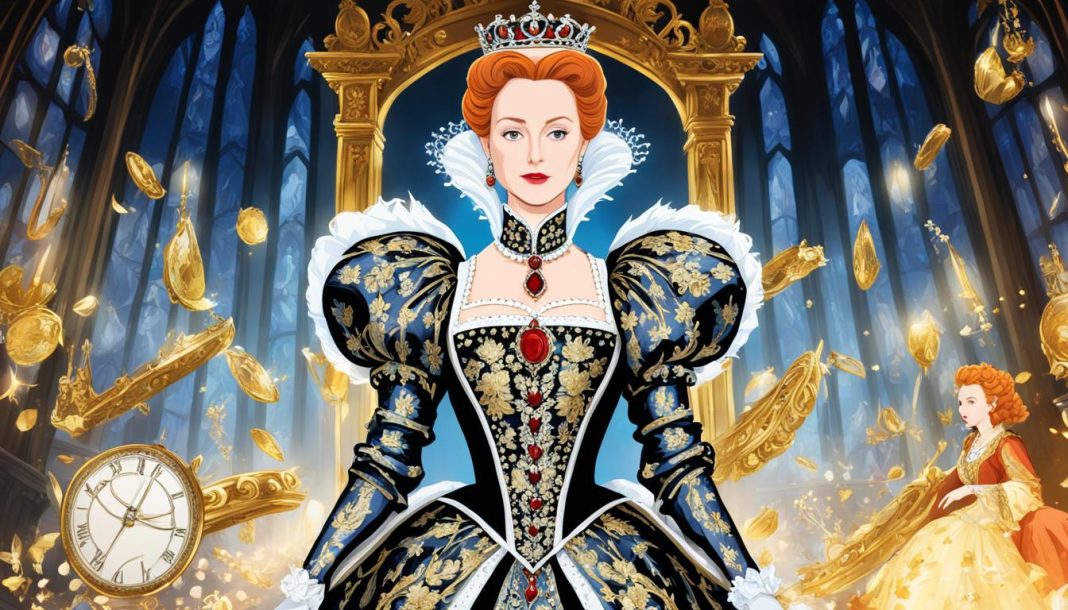Unveiling the Legacy of Queen Elizabeth I Story

What do you really know about Queen Elizabeth I, the iconic monarch of Tudor England? Was she merely the Virgin Queen or did her reign encompass more than meets the eye? Join us on a journey through the Elizabethan era as we delve into the life and lasting impact of Queen Elizabeth I, exploring her role as an English monarch, her influence on the Golden Age, and the secrets hidden within her portraits.
Key Takeaways:
- Queen Elizabeth I ruled England for 44 years, leaving a lasting impact on English history.
- She played a crucial role in shaping Tudor England and establishing the House of Tudor as an influential dynasty.
- Queen Elizabeth I’s portraits were essential in shaping her public image and conveying symbolism during the Elizabethan era.
- These portraits provide valuable insights into the queen’s appearance and the artistic techniques of the time.
- The historical narrative often overlooks women’s contributions, highlighting the need for greater recognition and inclusivity.
The Significance of Queen Elizabeth I’s Portraits.
Queen Elizabeth I’s reign during the Elizabethan era was marked by the creation of numerous portraits that played a crucial role in shaping her public image as the queen of England. While many portraits of her exist, only a few were actually painted from life, making them rare and precious artifacts of this influential monarch’s reign.
These portraits served as a means of conveying Queen Elizabeth I’s image and message to the public. They were carefully designed and replicated to meet the demand for her portraits, providing people across the country and beyond with a visual representation of their queen. Artists of the time skillfully used various techniques to capture the likeness and essence of Queen Elizabeth I, making each portrait a unique piece of art.
The symbolism embedded in these portraits was of great significance and reflected the political and social climate of the Elizabethan era. Artists used symbolism to convey messages about the queen’s power, virtue, and grandeur. For example, some portraits depicted Queen Elizabeth I with attributes associated with wisdom and prudence, symbolizing her leadership and the stability of the realm. Others showcased her regal attire, emphasizing her status as the ruler of England.
“Artists used the medium of portraiture to shape and reinforce Queen Elizabeth I’s public image, helping to establish her as a powerful and influential English monarch during the Elizabethan era.”
These portraits not only provided visual representations of the queen but also served as political tools. Queen Elizabeth I understood the power of these images in shaping public perception and used them strategically to reinforce her authority and legitimacy as the ruler of England. The portraits helped to create a sense of continuity and stability in the realm, contributing to the queen’s public persona as a strong and capable leader.
The significance of Queen Elizabeth I’s portraits extends beyond her reign. These artworks continue to captivate and inspire people today, offering a glimpse into the life and legacy of this remarkable queen. Through these portraits, we can explore the artistry of the Elizabethan era, the talent of the artists who painted them, and the enduring impact of Queen Elizabeth I on English history.
The Symbolism in Queen Elizabeth I’s Portraits
Every brushstroke in Queen Elizabeth I’s portraits was deliberate, with each detail carrying symbolic significance. Artists strategically incorporated symbols and motifs to communicate specific messages about the queen and her reign.
For instance, the use of pearls in her portraits symbolized purity and chastity, highlighting her reputation as the Virgin Queen. Pearls were a popular motif in Elizabethan portraiture, emphasizing the queen’s aura of virtue and the sacredness of her position.
The Role of Artists
The artists who painted Queen Elizabeth I’s portraits played a vital role in shaping her public image. These skilled artists captured not only the queen’s physical appearance but also her personality and essential qualities through their artistic interpretation.
Some notable artists who portrayed Queen Elizabeth I include Nicholas Hilliard and Isaac Oliver. Their masterful techniques and attention to detail helped create iconic representations of the queen that have endured through the centuries.
The artistry of these portraits, coupled with the royal patronage of Queen Elizabeth I, made them sought-after and prestigious. Artists vied for the opportunity to paint the queen’s portrait, further contributing to her enduring legacy as a symbol of power and beauty.
Queen Elizabeth I’s portraits continue to fascinate art enthusiasts, historians, and admirers of her reign. These remarkable artworks offer a glimpse into the life and reign of one of England’s most iconic monarchs, capturing the essence of the Elizabethan era and immortalizing Queen Elizabeth I’s public image.
An Analysis of Queen Elizabeth I’s Early Portraits.
One of the early portraits of Queen Elizabeth I, believed to date back to around 1560, provides intriguing insights into the queen’s appearance and the artistic techniques employed during that period. This portrait showcases several distinct features that would later become recognizable in her subsequent portraits.
For instance, Queen Elizabeth I’s iconic red hair and narrow nose are evident in this early depiction, setting the groundwork for her visual representation in later artworks. These defining characteristics became key elements in establishing the queen’s recognizable image.
Technical analysis of this portrait has unveiled interesting details about its original state. The background, once vibrant and resplendent in a shade of blue, has unfortunately faded over time, diminishing its initial impact. Despite this deterioration, the portrait still offers valuable insights into the queen’s artistic portrayal.
The underdrawing found in the face of the painting presents an intriguing revelation. This underdrawing suggests that multiple versions of this particular portrait were painted during the early years of Queen Elizabeth I’s reign. The presence of alternative artistic renderings highlights the importance of experimentation and revision in capturing the essence of the queen’s likeness.
These early portraits serve as a testament to the skill and creativity of the artists who sought to depict Queen Elizabeth I’s appearance. Through their masterful techniques, they were able to capture her features and create a lasting impression for future generations to admire.
These early portrayals of Queen Elizabeth I not only provide a glimpse into her physical appearance but also serve as a window into the artistic practices of the time. The use of underdrawing and the exploration of different versions showcase the complexities and nuances involved in capturing the essence of a prominent figure.
The ‘Darnley Portrait’ of Queen Elizabeth I.
The ‘Darnley Portrait’ of Queen Elizabeth I, painted around 1575, is considered one of the most important surviving portraits of the queen. This portrait showcases her face and attire, following a well-established pattern that was reused in later portraits.
Analysis of the colors used in the portrait revealed that the reds in the flesh paint have faded over time, and the whole painting would have appeared much more vibrant during its creation. The style and technique used in this portrait suggest the involvement of multiple artists.
The underdrawing in the hand indicates changes made during the painting process.
Unveiling the Hidden Symbolism in a Portrait of Queen Elizabeth I.
Another captivating portrait of Queen Elizabeth I, dating back to the late 1580s or early 1590s, reveals intriguing hidden details and symbolism that enrich our understanding of this iconic monarch. In this particular portrait, Queen Elizabeth I was originally depicted holding a serpent, a symbol associated with wisdom, prudence, but also with the notions of evil and original sin.
However, during the painting process, the serpent was later replaced with a bunch of roses, likely due to the ambiguous nature of the emblem. This alteration highlights the careful consideration given by the artists to the symbolism portrayed in Elizabeth’s portraits, aiming to present a powerful and multi-faceted image to the public.
This portrait also provides a glimpse into artistic practices during the sixteenth century, as it unveils an unfinished portrait of a different sitter subtly hidden beneath the surface. This reveals the reuse of painting panels, a common practice among artists of that era, showcasing both the technical skill and resourcefulness of Elizabethan painters.
The inclusion of hidden symbolism and the artistic techniques employed in this portrait further attest to the complexity and significance of the Elizabethan era, capturing the essence of Queen Elizabeth I’s reign and her enduring influence on English history.
The Intricacies of Symbolism
This portrait’s substitution of the serpent with roses suggests the deliberate decisions made by the artist or patron to convey a specific message through symbolism. While the serpent traditionally represents both positive and negative attributes, the replacement with roses could signify Elizabeth’s desire to associate herself with beauty, love, and the femininity often associated with these blossoms.
The interchangeability of symbols in Queen Elizabeth I’s portraits reflects the complexity of her public image, showcasing her ability to embody both strength and grace.
The Queen Uncovered: An Examination of a Portrait of Queen Elizabeth I.
The ‘Queen Uncovered’ portrait of Queen Elizabeth I, painted around 1585-90, offers a glimpse into a crucial phase of the queen’s reign. This captivating depiction reveals not only her regal power but also her immense wealth, highlighted by her opulent dress and elaborate headdress.
In the background of the portrait, we find a globe, symbolizing England’s exploration and conquest during the era. It serves as a potent reminder of the global awareness and influence of Queen Elizabeth I’s reign. Her rule connected England to the wider world, bringing about unprecedented advances in trade and colonial expansion.
The portrait also features an intriguing inscription on the rim of a sieve held by the queen. This inscription represents Queen Elizabeth I’s discernment and ability to separate the good from the bad within her realm. It serves as a metaphor for her wise and judicious rule, ensuring only virtuous counsel and decisions come through.
This portrait, painted by George Gower, exhibits the masterful use of symbolism to reinforce Queen Elizabeth I’s image as a sagacious and virtuous ruler. It captures a pivotal moment in her reign, showcasing the queen’s power, wealth, and global awareness while hinting at her discerning judgment and ability to navigate complex political landscapes.
The Role of Portraiture in Elizabethan Propaganda.
During the Elizabethan era, the use of portraits as a tool for propaganda played a crucial role in shaping public perception of Queen Elizabeth I. Each portrait was meticulously designed to convey specific messages about the queen’s virtue, wisdom, and divine right to rule. Through the strategic placement of royal coat of arms, Latin and Italian inscriptions, and the use of symbolism, these portraits reinforced the image of Queen Elizabeth I as a strong and capable ruler.
The symbolism incorporated into these portraits was intended to evoke a sense of power and authority. For instance, the inclusion of regal attributes such as crowns, scepters, and globes symbolized the queen’s sovereignty and global influence. The use of specific colors, such as red and gold, further emphasized her regal status. These artistic choices were carefully crafted to create a sense of admiration and reverence among the queen’s subjects.
Furthermore, the portraits of Queen Elizabeth I showcased her divine right to rule. The presence of religious symbols, such as the orb and cross, depicted her as a chosen leader appointed by God. These symbols reinforced the notion that her reign was sanctioned by a higher power and further legitimized her authority.
The inscriptions found in these portraits also played a significant role in conveying the queen’s message. Latin and Italian phrases, often referring to virtue, wisdom, and piety, were used to highlight the queen’s character and moral qualities. These linguistic choices aimed to portray her as a virtuous and just ruler, dedicated to the welfare of her subjects.
Overall, the portraits of Queen Elizabeth I served as powerful tools of propaganda, shaping public perception and cementing her authority in the minds of her subjects. The careful use of symbolism, divine right imagery, and inscriptions all contributed to constructing an image of a strong and capable leader. These portraits continue to offer valuable insights into the Elizabethan era and the legacy of one of England’s most influential monarchs.
The Enduring Influence of Queen Elizabeth I.
Queen Elizabeth I’s reign left an enduring influence on English history. Her rule during the Elizabethan era is often referred to as the Golden Age, characterized by flourishing arts, literature, and exploration. The stability and prosperity experienced under her leadership set a foundation for future generations. Queen Elizabeth I’s legacy as a powerful and influential monarch continues to be celebrated and studied to this day.
The Golden Age of Queen Elizabeth I’s reign marked a significant period in English history. It was a time of cultural and intellectual growth, where the arts flourished and advancements were made in literature, theater, and music. The works of iconic playwrights such as William Shakespeare thrived during this era, leaving a lasting impact on the world of literature.
“I know I have the body but of a weak and feeble woman; but I have the heart and stomach of a king, and of a king of England, too.” – Queen Elizabeth I
Queen Elizabeth I’s enduring influence is also seen in the realm of exploration and colonization. The English voyages to the New World, such as those led by Sir Francis Drake and Sir Walter Raleigh, paved the way for the establishment of colonies and trade routes that extended England’s influence across the globe.
The stability and prosperity experienced during Queen Elizabeth I’s reign created a sense of national pride and unity among the English people. Her ability to navigate through religious and political challenges earned her the admiration and respect of her subjects. Queen Elizabeth I’s reign set the stage for the development of a strong and prosperous nation.
Even centuries after her death, Queen Elizabeth I remains an iconic figure in English history. Her legacy as the Virgin Queen and the symbol of the Golden Age continues to inspire and captivate individuals around the world. Through her enduring influence, Queen Elizabeth I has left an indelible mark on English history that will be cherished and celebrated for generations to come.
The Historical Gap in Recognizing Women’s Contributions.
The historical narrative has often overlooked the contributions of women, leaving a significant gap in recognizing their achievements and roles in shaping history. Throughout the ages, women have made significant contributions in various fields, such as science, literature, art, politics, and social activism. However, their stories and accomplishments have been overshadowed, dismissed, or simply erased from the historical record.
Despite the historical gaps, there has been a growing awareness and effort to shed light on women’s contributions in recent years. Scholars, historians, and activists have diligently worked to uncover and revive the stories of remarkable women who have made substantial impacts on society. By championing women’s accomplishments, we can create a more accurate and inclusive historical narrative.

Women’s contributions throughout history deserve recognition and celebration. From the powerful rulers and politicians to the groundbreaking scientists and artists, women have played an integral role, shaping the world we live in today.
“It is essential to acknowledge and celebrate the achievements of women throughout history and establish a more inclusive historical narrative.”
Shedding Light on Forgotten Stories
Unearthing the stories of remarkable women from the past not only gives them the recognition they deserve but also provides us with a broader understanding of history. By uncovering and documenting women’s achievements, we gain valuable insights into their struggles, resilience, and the barriers they overcame. These stories serve as a source of inspiration for future generations, affirming the idea that gender should never be a limitation.
Empowering Women’s Voices
Providing a platform for women to share their stories and experiences is crucial in bridging the historical gap. Women’s voices need to be heard and amplified. By elevating their narratives, we can challenge existing stereotypes, reshape the narrative, and promote gender equity. Empowering women to share their stories not only enriches our understanding of the past but also inspires a more inclusive and diverse future.
The historical gap in recognizing women’s contributions can be bridged through continued research, education, and advocacy. By actively seeking out and celebrating the achievements of women, we can reshape the historical narrative and ensure a more accurate representation of our shared history.
The Importance of Rediscovering Women in History.
Rediscovering the stories of women in history is crucial for understanding the full extent of their contributions and accomplishments. Throughout history, women have made significant and lasting impacts in various fields, ranging from politics to science, arts to philanthropy. Yet, their achievements have often been overshadowed or overlooked by the dominant historical narrative that emphasizes the accomplishments of men. By bringing their stories to light, we can inspire future generations and promote a more inclusive and accurate understanding of history.
“Women’s contributions to history are invaluable. It is essential that we acknowledge the perseverance and achievements of women, as their stories have been essential to shaping the world we live in today.” – Dr. Jane Williams, Historian and Women’s Studies Expert
By highlighting the accomplishments of women in history, we can challenge the traditional narratives that have marginalized or excluded them. These stories serve as powerful examples of determination, resilience, and the ability to overcome societal barriers. By recognizing and celebrating women’s contributions, we empower future generations to dream big and break through the limitations imposed by gender norms.
Furthermore, rediscovering the stories of women in history helps correct historical inaccuracies and biases. It allows us to uncover the hidden figures who played pivotal roles in shaping our societies but have often been forgotten or erased from historical records. By amplifying their voices and acknowledging their achievements, we provide a more accurate representation of the past.
Ultimately, the importance of rediscovering women in history lies in the power of representation. When women’s contributions are acknowledged and celebrated, it sends a powerful message to present and future generations that their voices matter, their accomplishments are significant, and their place in history is undeniable.
Empowering Women to Share Their Stories.
Empowering women to share their stories is crucial in amplifying their voices and ensuring their representation in historical narratives. It is through sharing personal experiences and accomplishments that women can break down barriers and challenge traditional narratives that often exclude or marginalize them. By providing platforms and opportunities for women to share their voices, we can reshape the historical landscape and create a more accurate and inclusive understanding of our past.
Sharing stories not only empowers individual women but also strengthens the collective memory of society. Each story told becomes a piece of a larger puzzle, enriching our understanding of history and highlighting the diverse contributions that women have made. Representation matters, and by giving women the space to share their stories, we can ensure that their voices are heard, their perspectives are valued, and their impact is acknowledged.
When women share their stories, they inspire others and create a ripple effect of empowerment. By hearing about the challenges women have overcome, the milestones they have achieved, and the invaluable insights they have gained, future generations of women are motivated to strive for greatness. Women’s stories serve as a beacon of hope, reminding us all of the strength, resilience, and determination that can be found within every woman.
“Women’s stories are an essential part of our history, and their voices deserve to be heard. By sharing our experiences, we not only empower ourselves, but we also inspire others to find their own voice and embrace their unique journey.”
Furthermore, when women share their stories, they challenge societal norms and pave the way for change. Their narratives disrupt the status quo and challenge the perception of what it means to be a woman, opening up new possibilities and opportunities for future generations. By diversifying the stories we tell and the voices we listen to, we dismantle the barriers that have perpetuated inequality and encourage a more inclusive and equitable society.
It is time to uplift women’s stories, celebrate their achievements, and ensure their rightful place in history. By empowering women to share their experiences, we create a virtuous cycle of representation, inspiration, and progress. Together, let’s amplify women’s voices, reshape historical narratives, and build a future where every woman’s story counts.
Conclusion.
Queen Elizabeth I’s remarkable reign and enduring legacy have underscored the significance of recognizing women’s contributions and empowering them to share their stories. By delving into the life and achievements of Queen Elizabeth I and shedding light on the remarkable accomplishments of women throughout history, we can create a more comprehensive and accurate historical narrative.
Queen Elizabeth I’s reign during the Elizabethan era, often referred to as the Golden Age, left an indelible mark on English history. Her leadership and patronage of the arts, literature, and exploration led to unprecedented advancements and prosperity. Through her enduring influence, Queen Elizabeth I demonstrated the remarkable impact women can have on shaping the world.
It is crucial to continue the work of celebrating and honoring the women who have profoundly influenced our society. By recognizing their achievements, we can inspire future generations and create a more inclusive historical narrative that accurately reflects the significant contributions made by women throughout history.
Let us strive to uncover forgotten stories, embrace representation, and give voice to the women whose remarkable legacies have shaped our world. By doing so, we honor not only Queen Elizabeth I but also the countless women who have defied societal expectations, shattered glass ceilings, and left an indelible mark on history.
Thanks For Reading…Unveiling the Legacy of Queen Elizabeth I
How much did you like Unveiling the Legacy of Queen Elizabeth I? Please share your views in the comment box. Also, please share this story with your friends on social media so they can enjoy it, and for more such stories, please bookmark storiespub.com.
Check out other stories that we have:
























